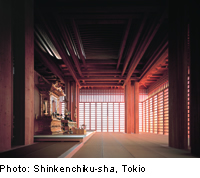Buddhist Temple in Saijo

Some 250 years ago, the Komyo-Ji Temple complex was erected in the coastal town of Saijo, Japan, by the Jodo sect. In contrast to other Buddhist sects, it does not promise redemption solely to selected monks, but to members of all social classes. Plans existed to demolish the dilapidated temple buildings and renew them completely. Tadao Ando, how-ever, proposed the retention of the surrounding walls, a number of trees, the entrance gate and the bell tower, and the construction of a new main hall and ancillary buildings.
The restrained temple hall is situated in the middle of the site. It is flanked by a guest tract and columbarium and is surrounded by a pool of water that is fed by mountain streams – asymbol of the importance of water in the ritual cleansing process. Internally, the hall is divided from the peripheral corridor by large pine wall elements with obscured glass. The hall can be extended by opening the walls.
The dominant material internally and externally is timber, which is an architectural expression of the forest and nature. One of the themes of the construction is the jointing of elements to create a unity. Laminated members were used as a more economical alternative to solid timber. A number of beam layers are supported on four column sheaves to form a three-dimensional roof structure. Transparency, layering and additive construction are combined here to achieve architectural unity.
